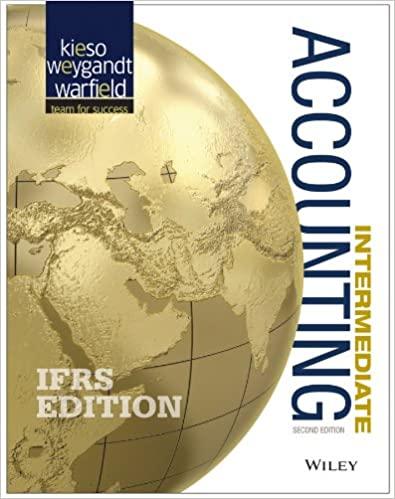Hi! could you please show the calculations, thanks:)

160 $ 30 Scrappers Supplies tracks the number of units purchased and sold throughout each accounting period but applles its inventory calling method at the end of each period, as if it uses a periodic inventory system. Assume its accounting records provided the following information at the end of the annual accounting period, December 31 Transactions Units Unit Cost Beginning inventory) January 1 Transactions during the year! a. Purchase on account, March 2 280 32 b. Cash sale, April 1 (546 each) (310) c. Purchase on account, June 30 210 36 d. Cash sale, August 1 (546 each) (60) TIP: Although the purchases and sales are listed in chronological order, Scrappers determines the cost of goods told after all of the purchases have occurred Required: 1. Compute the cost of goods available for sale. cost of ending Inventory, and cost of goods sold at December 31 under each of the following inventory costing methods: (Round "Cost per Unit" to 2 decimal places) a. Last-in, first-out b. Weighted average cost c. First-in, first-out d. Specific identification, assuming that the April 1 sale was selected one-fifth from the beginning inventory and your fifths from the purchase of March 2 Assume that the sale of August 1 was selected from the purchase of June 30 2. Of the four methods, which will result in the highest gross profit? Which will result in the lowest income taxes? Answer is not complete. Complete this question by entering your answers in the tabs below. Reg 1A Req 18 Reg 10 Req ID Req 2A Reg 28 a. Compute the cost of goods available for sale, cost of ending inventory, and cost of goods sold at December 31 using the LIFO method. (Round "Cost per Unit" anwers to 2 decimal places.) LIFO (Periodic Units Total Cost per Unit $ 30.00 $ 180 4,800 Beginning Inventory Purchases is 12.00 36.00 S March 2 June 30 Total Purchases Goods Available for Sale 280 210 490 050 10.920 15.720 50 Cost of Goods Sold Units from Beginning Inventory Units from March 2 Purchase Units from June 30 Purchase Total Cost of Goods Sold Ending inventory 100 X 5 210 XS 0% S 370 280 30.00 12.00 X 0.00 X S 74320 8.400 Reg 18> Answer is not complete. Complete this question by entering your answers in the tabs below. Reg 1A Reg 18 Reg 1C Req 10 Reg 2A Reg 2B b. Compute the cost of goods available for sale, cost of ending inventory, and cost of goods sold at December 31 using the Weighted average method. (Round "Cost per Unit" anwers to 2 decimal places.) Units Cost per Unit 30.00 Total 160 IS 5 4.800 Weighted Average Cost Periodic Beginning Inventory Purchases March 2 June 30 Total Purchases Goods Available for Sale Cost of Goods Sold Ending Inventory 280 IS 210ls 490 32.00 36.00 650 370 10.520 15.7208 0 6.770 S 280 $ Answer is not complete. Complete this question by entering your answers in the tabs below. Req 1A Req 18 Req 1C Req 1D Req 2A Reg 28 c. Compute the cost of goods available for sale, cost of ending inventory, and cost of goods sold at December 31 using the FIFO method. (Round "Cost per Unit" anwers to 2 decimal places.) FIFO (Periodio) Units Cost per Total Unit 30.00ls 160 $ 4,800 s 280 210 12.00 X 36.00 S 490 10,020 850 > 15,720 Beginning inventory Purchases March 2 June 30 Total Purchases Goods Available for Sale Cost of Goods Sold Units from Beginning Inventory Units from March 2 Purchase Units from June 30 Purchase Total Cost of Goods Sold Ending Inventory 0 XS 0.00 $ 12.00 36.00 180 X $ 210 X 370 280 9.480 3,300 % IS Answer is not complete. Complete this question by entering your answers in the tabs below. Req 1A Req 18 Reg 10 Req 10 Req 2A Req 28 d. Compute the cost of goods available for sale, cost of ending inventory, and cost of goods sold at December 31 using the Specific identification method. Assume that the April 1 sale was selected one-fifth from the beginning inventory and four-fifths from the purchase of March 2. Assume that the sale of August 1 was selected from the purchase of June 30. (Round "Cost per Unit" anwers 2 decimal places.) Show less Units Total Cost per Unit Is 30.00 IS 180 4,800 Specific Identification (Periodic) Beginning Inventory Purchases March 2 12.00 30.00 June 30 w 280 210 400 650 Total Purchases 10,020 15,720 Goods Available for Sale Cost of Goods Sold Units from Beginning Inventory Units from March 2 Purchase Units from June 30 Purchase Total Cost of Goods Sold Ending Inventory 98 S 32 X ls 60 IS 30.00 12.00 X 36.00 100 280 5,484 5.484 X $












